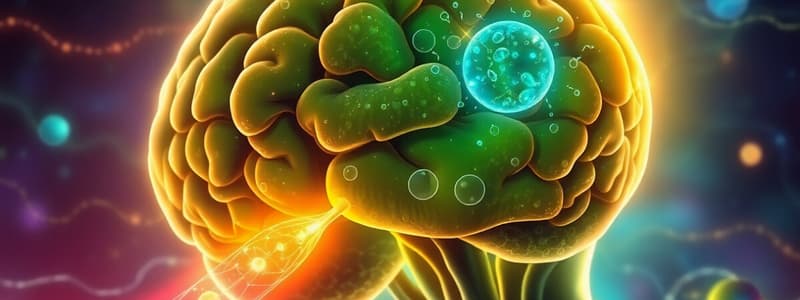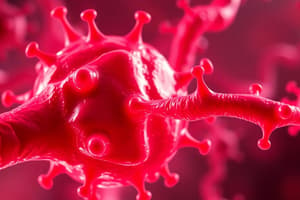Podcast
Questions and Answers
What are psychoactive drugs?
What are psychoactive drugs?
Drugs that influence subjective experience and behavior by acting on the nervous system.
Which route of drug administration involves absorption via the digestive tract?
Which route of drug administration involves absorption via the digestive tract?
- Ingestion (correct)
- Inhalation
- Injection
- Absorption through mucous membranes
Which of the following is NOT a characteristic of drug administration via inhalation?
Which of the following is NOT a characteristic of drug administration via inhalation?
- Rapid absorption
- Slow action (correct)
- Used for anesthetics, asthma medication, tobacco, and cannabis
- Absorbed through capillaries in lungs
Which injection route delivers a drug directly into the brain?
Which injection route delivers a drug directly into the brain?
Based on the typical concentration curves in the brain, which route of administration generally leads to the fastest and highest peak concentration?
Based on the typical concentration curves in the brain, which route of administration generally leads to the fastest and highest peak concentration?
For a psychoactive drug to affect behavior, it must cross the blood-brain barrier.
For a psychoactive drug to affect behavior, it must cross the blood-brain barrier.
How are the actions of most drugs terminated in the body?
How are the actions of most drugs terminated in the body?
What is drug tolerance?
What is drug tolerance?
Tolerance develops equally to all effects of a drug.
Tolerance develops equally to all effects of a drug.
What is cross-tolerance?
What is cross-tolerance?
Which type of drug tolerance involves decreased responsiveness at the site of action (e.g., fewer receptors, reduced binding efficiency)?
Which type of drug tolerance involves decreased responsiveness at the site of action (e.g., fewer receptors, reduced binding efficiency)?
What is drug sensitization?
What is drug sensitization?
What is contingent drug tolerance?
What is contingent drug tolerance?
What is conditioned drug tolerance?
What is conditioned drug tolerance?
Conditioned drug tolerance suggests that addicts are more likely to overdose in familiar surroundings.
Conditioned drug tolerance suggests that addicts are more likely to overdose in familiar surroundings.
What are conditioned compensatory responses?
What are conditioned compensatory responses?
What are drug withdrawal symptoms?
What are drug withdrawal symptoms?
Physical dependence is the primary reason why addicts relapse long after detoxification.
Physical dependence is the primary reason why addicts relapse long after detoxification.
According to positive-incentive theories, why do addicts take drugs?
According to positive-incentive theories, why do addicts take drugs?
In the incentive-sensitization theory, what does 'liking' refer to?
In the incentive-sensitization theory, what does 'liking' refer to?
In the incentive-sensitization theory, what does 'wanting' refer to?
In the incentive-sensitization theory, what does 'wanting' refer to?
According to incentive-sensitization theory, with chronic drug use, people tend to crave drugs more and enjoy them less.
According to incentive-sensitization theory, with chronic drug use, people tend to crave drugs more and enjoy them less.
Match the cause of relapse with its description:
Match the cause of relapse with its description:
What is intracranial self-stimulation (ICSS)?
What is intracranial self-stimulation (ICSS)?
Which dopamine pathway projects from the substantia nigra to the striatum and is primarily involved in movement control?
Which dopamine pathway projects from the substantia nigra to the striatum and is primarily involved in movement control?
Which dopamine pathway projects from the ventral tegmental area (VTA) to the cortex and limbic system (including the nucleus accumbens) and is heavily implicated in reward and addiction?
Which dopamine pathway projects from the ventral tegmental area (VTA) to the cortex and limbic system (including the nucleus accumbens) and is heavily implicated in reward and addiction?
What effect do dopamine agonists generally have on intracranial self-stimulation (ICSS)?
What effect do dopamine agonists generally have on intracranial self-stimulation (ICSS)?
What effect do lesions of the mesocorticolimbic pathway (e.g., nucleus accumbens or VTA) have on drug self-administration?
What effect do lesions of the mesocorticolimbic pathway (e.g., nucleus accumbens or VTA) have on drug self-administration?
What does the drug self-administration paradigm measure in laboratory animals?
What does the drug self-administration paradigm measure in laboratory animals?
What does the conditioned place preference (CPP) paradigm measure?
What does the conditioned place preference (CPP) paradigm measure?
Dopamine antagonists block the rewarding effects of addictive drugs and natural reinforcers like food.
Dopamine antagonists block the rewarding effects of addictive drugs and natural reinforcers like food.
Studies like Volkow et al. (2002) show that dopamine D2 receptor availability is typically increased in the brains of individuals addicted to drugs like cocaine, meth, alcohol, and heroin.
Studies like Volkow et al. (2002) show that dopamine D2 receptor availability is typically increased in the brains of individuals addicted to drugs like cocaine, meth, alcohol, and heroin.
Which brain structure is particularly implicated in mediating the rewarding effects of drugs, as evidenced by animals self-administering drugs directly into it and lesions disrupting drug-seeking behavior?
Which brain structure is particularly implicated in mediating the rewarding effects of drugs, as evidenced by animals self-administering drugs directly into it and lesions disrupting drug-seeking behavior?
Both addictive drugs (like amphetamine, cocaine, morphine, nicotine) and natural rewards (like food and sex) cause an increase in dopamine release in the nucleus accumbens.
Both addictive drugs (like amphetamine, cocaine, morphine, nicotine) and natural rewards (like food and sex) cause an increase in dopamine release in the nucleus accumbens.
What structural change has been observed in the neuronal dendrites within the nucleus accumbens following cocaine self-administration?
What structural change has been observed in the neuronal dendrites within the nucleus accumbens following cocaine self-administration?
What are psychoactive drugs?
What are psychoactive drugs?
Psychoactive drugs influence subjective experience and behavior by acting on the _____ _____.
Psychoactive drugs influence subjective experience and behavior by acting on the _____ _____.
What primary factor influences the rate and degree to which a drug reaches its site of action?
What primary factor influences the rate and degree to which a drug reaches its site of action?
Which drug administration route is generally easy and relatively safe but characterized by slow action and unpredictable absorption?
Which drug administration route is generally easy and relatively safe but characterized by slow action and unpredictable absorption?
Which administration route involves rapid absorption through capillaries in the lungs?
Which administration route involves rapid absorption through capillaries in the lungs?
Match the form of injection with its description:
Match the form of injection with its description:
Based on typical drug concentration curves, which administration route generally leads to the fastest and highest peak concentration in the brain?
Based on typical drug concentration curves, which administration route generally leads to the fastest and highest peak concentration in the brain?
For a psychoactive drug to have an effect, it must first pass through the - _____ to reach the brain.
For a psychoactive drug to have an effect, it must first pass through the - _____ to reach the brain.
The actions of most drugs are terminated by enzymes in the liver through a process called drug _____.
The actions of most drugs are terminated by enzymes in the liver through a process called drug _____.
What is drug tolerance?
What is drug tolerance?
Tolerance develops equally to all effects of a given drug.
Tolerance develops equally to all effects of a given drug.
What is cross-tolerance?
What is cross-tolerance?
Distinguish between metabolic and functional tolerance.
Distinguish between metabolic and functional tolerance.
What is drug sensitization?
What is drug sensitization?
Contingent drug tolerance refers to the finding that tolerance develops only to drug effects that are actually _____.
Contingent drug tolerance refers to the finding that tolerance develops only to drug effects that are actually _____.
What is conditioned drug tolerance?
What is conditioned drug tolerance?
Addicts are more likely to overdose in familiar surroundings compared to unfamiliar ones.
Addicts are more likely to overdose in familiar surroundings compared to unfamiliar ones.
Environmental cues associated with drug-taking can elicit conditioned _____ responses, producing tolerance prior to drug use.
Environmental cues associated with drug-taking can elicit conditioned _____ responses, producing tolerance prior to drug use.
How do drug withdrawal symptoms typically relate to the drug's direct effects?
How do drug withdrawal symptoms typically relate to the drug's direct effects?
Once physical withdrawal symptoms subside, drug craving typically disappears.
Once physical withdrawal symptoms subside, drug craving typically disappears.
According to the incentive-sensitization theory, what happens to 'liking' (hedonic value) and 'wanting' (incentive value) with chronic drug use?
According to the incentive-sensitization theory, what happens to 'liking' (hedonic value) and 'wanting' (incentive value) with chronic drug use?
List three common triggers for relapse in addiction.
List three common triggers for relapse in addiction.
What is intracranial self-stimulation (ICSS)?
What is intracranial self-stimulation (ICSS)?
Which major dopamine pathway, projecting from the ventral tegmental area (VTA) to the cortex and limbic system, is most implicated in reward and addiction?
Which major dopamine pathway, projecting from the ventral tegmental area (VTA) to the cortex and limbic system, is most implicated in reward and addiction?
Degeneration of dopaminergic neurons in the _____ pathway is the primary cause of motor symptoms in Parkinson's disease.
Degeneration of dopaminergic neurons in the _____ pathway is the primary cause of motor symptoms in Parkinson's disease.
Dopamine _____ tend to increase intracranial self-stimulation (ICSS), while dopamine _____ tend to decrease it.
Dopamine _____ tend to increase intracranial self-stimulation (ICSS), while dopamine _____ tend to decrease it.
Briefly describe the drug self-administration paradigm.
Briefly describe the drug self-administration paradigm.
Briefly describe the conditioned place preference (CPP) paradigm.
Briefly describe the conditioned place preference (CPP) paradigm.
Dopamine plays a crucial role in the rewarding effects of addictive drugs and _____ reinforcers like food and sex.
Dopamine plays a crucial role in the rewarding effects of addictive drugs and _____ reinforcers like food and sex.
Research indicates that Dopamine D2 receptors are often _____ in density or availability in the brains of individuals addicted to various drugs.
Research indicates that Dopamine D2 receptors are often _____ in density or availability in the brains of individuals addicted to various drugs.
Animals will self-administer microinjections of addictive drugs directly into the _____ _____, a key structure in the brain's reward pathway.
Animals will self-administer microinjections of addictive drugs directly into the _____ _____, a key structure in the brain's reward pathway.
Lesions of the nucleus accumbens or the ventral tegmental area typically block both drug - and drug-related _____ _____.
Lesions of the nucleus accumbens or the ventral tegmental area typically block both drug - and drug-related _____ _____.
Repeated self-administration of drugs like cocaine can lead to an increase in the number and complexity of dendritic _____ on neurons within the nucleus accumbens.
Repeated self-administration of drugs like cocaine can lead to an increase in the number and complexity of dendritic _____ on neurons within the nucleus accumbens.
Flashcards
What are psychoactive drugs?
What are psychoactive drugs?
Drugs that influence subjective experience and behavior by acting on the nervous system.
What influences drug absorption?
What influences drug absorption?
The rate and degree to which a drug reaches its site of action.
What is drug ingestion?
What is drug ingestion?
Oral administration; easy, relatively safe, but slow and unpredictable due to absorption via the digestive tract.
What is drug inhalation?
What is drug inhalation?
Signup and view all the flashcards
What is drug injection?
What is drug injection?
Signup and view all the flashcards
Absorption through mucous membranes
Absorption through mucous membranes
Signup and view all the flashcards
What does the route of drug administration determine?
What does the route of drug administration determine?
Signup and view all the flashcards
What must a psychoactive drug do to have an effect?
What must a psychoactive drug do to have an effect?
Signup and view all the flashcards
How are most drugs terminated?
How are most drugs terminated?
Signup and view all the flashcards
What is drug tolerance?
What is drug tolerance?
Signup and view all the flashcards
What is cross tolerance?
What is cross tolerance?
Signup and view all the flashcards
What is metabolic tolerance?
What is metabolic tolerance?
Signup and view all the flashcards
What is functional tolerance?
What is functional tolerance?
Signup and view all the flashcards
What is drug sensitization?
What is drug sensitization?
Signup and view all the flashcards
What is contingent drug tolerance?
What is contingent drug tolerance?
Signup and view all the flashcards
What is conditioned drug tolerance?
What is conditioned drug tolerance?
Signup and view all the flashcards
When is drug withdrawal observed?
When is drug withdrawal observed?
Signup and view all the flashcards
What is drug abuse?
What is drug abuse?
Signup and view all the flashcards
What is substance use disorder?
What is substance use disorder?
Signup and view all the flashcards
What does the physical-dependence theory not explain?
What does the physical-dependence theory not explain?
Signup and view all the flashcards
What is the positive-incentive theory?
What is the positive-incentive theory?
Signup and view all the flashcards
Incentive-sensitization theory
Incentive-sensitization theory
Signup and view all the flashcards
What is conditioned drug tolerance in relapse?
What is conditioned drug tolerance in relapse?
Signup and view all the flashcards
What is intracranial self-stimulation (ICSS)?
What is intracranial self-stimulation (ICSS)?
Signup and view all the flashcards
What is the nigrostriatal pathway?
What is the nigrostriatal pathway?
Signup and view all the flashcards
What is the mesocorticolimbic pathway?
What is the mesocorticolimbic pathway?
Signup and view all the flashcards
How does dopamine relate to self-stimulation?
How does dopamine relate to self-stimulation?
Signup and view all the flashcards
What is the drug self-administration paradigm?
What is the drug self-administration paradigm?
Signup and view all the flashcards
What is Conditioned place preference?
What is Conditioned place preference?
Signup and view all the flashcards
What is dopamine's role in addiction?
What is dopamine's role in addiction?
Signup and view all the flashcards
What do dopamine antagonists do?
What do dopamine antagonists do?
Signup and view all the flashcards
How do animals act with nucleus accumbens and addictive drugs?
How do animals act with nucleus accumbens and addictive drugs?
Signup and view all the flashcards
What does cocaine self-administration do?
What does cocaine self-administration do?
Signup and view all the flashcards
Study Notes
- Drug addiction is related to the brain's reward circuits
- The notes were prepared by Charlis Raineki, PhD for PSYC/NEUR 2P37 on March 6, 2025
Learning Objectives
- Identify anatomical areas and neurotransmitter systems involved in reward pathways.
- Discuss basic principles of drug action.
- Discuss drug tolerance and drug withdrawal.
- Explain contingent and conditioned drug tolerance
Basic Principles of Drug Action
- Psychoactive drugs affect subjective experience and behavior by acting on the nervous system
Drug Administration and Absorption
- The route of drug administration impacts the rate and degree to which the drug reaches its site of action
- Ingestion involves the oral route, is easy and safe, results in slow action, and has unpredictable absorption via the digestive tract.
- Inhalation involves absorption through capillaries in the lungs, has rapid absorption, and applies only to a few drugs, such as anesthetics, asthma medication, tobacco, and cannabis.
- Injection allows direct delivery into systemic circulation, bypassing the digestive tract
- Injection has strong, fast, and predictable effects
- Forms of injection include subcutaneously (under the skin) and intramuscularly (into large muscles).
- Intravenously, injection goes into veins, and the drug is delivered directly to the brain
- Drugs can be absorbed through mucous membranes like the nose, mouth, and rectum
- The route of drug administration determines how fast a drug will act in the brain
Mechanisms of Drug Action
- Psychoactive drugs must reach the brain and bypass the blood-brain barrier to have an effect
- Most drugs act as ligands that bind to specific receptor molecules.
- Drugs can target one or a few receptor subtypes.
- Drug actions can vary widely because receptor subtypes have different localizations and functions
- Drug actions are terminated by enzymes in the liver through drug metabolism
- Small amounts of drugs may be excreted in urine, sweat, feces, breath, and mother’s milk
Drug Tolerance
- Drug tolerance is a decreased sensitivity to a drug as a consequence of exposure to it
- Drug tolerance involves a shift in the dose response curve to the right
- Tolerance often develops to some effects and not others
- Cross-tolerance means that tolerence to one drug can produce tolerance to similar drugs
- Cross-tolerance is observed between members of the same drug class
- Examples of cross tolerence are all opioids, alcohol and benzodiazepines and several amphetamines
- There are two types of drug tolerance:
- Metabolic, where less drug is getting to the site of action
- Functional, where there is decreased responsiveness at the site of action,
- Fewer receptors
- Decreased efficiency of binding at receptors
- Receptors that area less responsive
Drug Sensitization
- Drug sensitization is a progressive and persistent increase in a drug effect produced by repeated exposure to the same dose
Learning on Drug Tolerance
- Contingent drug tolerance means that tolerance only develops to drug effects that are experienced
- Conditioned drug tolerance: Maximal tolerance effects are seen in the environment where a drug is usually taken
- Addicts are more likely to overdose in unfamiliar surroundings
- Exteroceptive or interoceptive cues associated with drug taking become conditioned stimuli that elicit conditioned compensatory responses, producing tolerance prior to drug use
Drug Withdrawal
- Drug withdrawal is observed when drug use is terminated
- Withdrawal symptoms are the opposite of the drug's effects
- The body makes physical changes to compensate for the presence of the drug to facilitate normal functioning
- Severity of withdrawal symptoms vary according to the drug and the pattern of use
Drug Abuse vs. Drug Addiction
- Drug abuse is a maladaptive pattern of legal and illegal drug use
- This includes the repeated use of drugs to produce pleasure, alleviate stress, and/or alter or avoid reality
- Individuals with substance use disorder continue to use a drug despite its adverse effects on health and social life
- Addiction and physical dependence may occur together or separately
- Addicts may still crave the drug, even after withdrawal symptoms from physical dependence have subsided
Economic Costs of Drug Abuse and Addiction
- The estimated economic cost to society due to drug abuse and addiction in The USA totals $524 billion/year
- Illegal drugs cost $181 billion/year, alcohol costs $185 billion/year and tobacco costs $158 billion/year
- Economic costs include huge expenses for medical and social services
- Economic costs include Millions of hours lost in the workplace
- Economic costs include elevated rates of crime
- Economic costs include damage to many children from their parents' substance abuse behavior
Vulnerability to Drug Abuse and Addiction
- Biological factors:
- Sex
- Genetic predisposition
- Family situation:
- Family breakup
- Poor relationship with parents.
- Personal characteristics:
- Aggressiveness
- Poor emotional control
- Environmental factors include a high prevalence of drug use, especially within a peer group
Other factors related to Drug Abuse and Addiction
- Drug abuse/addiction is highly comorbid with other mental health disorders
- Self-medication happens when substance abuse begins to alleviate symptoms of mental illness
- Causal effects occur when substance abuse may increase vulnerability to mental illness
- Common or correlated causes occur when risk factors give rise to mental illness, and substance abuse may be related or overlap
Biopsychological Theories of Addiction
- Physical-dependence theory
- states that dependence due to pain of withdrawal does not explain why addicts relapse long after detoxification
- The pattern of drug taking routinely displays periods of binges and detoxification
- Addictions develop to drugs that do not produce severe withdrawal symptoms
- Positive-incentive theories
- Addicts take drugs not to escape unpleasant withdrawal
- Addicts are driven to obtain the drugs' pleasurable effects
- Incentive-sensitization theory
- states that it is not the hedonic value (liking) but the actual pleasure experienced
- states that it is the positive-incentive value (wanting): the anticipated pleasure associated with the action (taking the drug)
- As drug use increases, so does the positive-incentive value due to memory of the pleasure of early drug experience. The hedonic value decreases due to drug tolerance
- People with substance use disorder crave drugs more but enjoy them less
Relapse Causes
- Stress as a drug use coping mechanism
- Drug priming, where a single exposure leads to relapse
- Environmental cues within conditioned drug tolerance like going back to places where drugs were taken causes conditioned compensating responses craving and relapse
Intracranial Self-Stimulation (ICSS)
- Rats, humans, and many other species stimulate levers that deliver electrical stimuli to specific brain regions.
- Electrical stimuli delivered to the lateral hypothalamic regions, septum, and midbrain dopamine system
- Activity in these brain regions is proposed drives the pleasure of natural rewards, such as food and sex
Mesotelencephalic Dopamine System
- Nigrostriatal pathway (green) Dopaminergic neurons project from substantia nigra to the striatum
- This pathway controls movement, motor sequences, and habits Degeneration of neurons in Parkinson's disease
- Mesocorticolimbic pathway (red) Dopaminergic neurons project from ventral tegmental area to the cortex and limbic system
- This pathway helps with experiencing pleasure and obtaining reward Neurons that project to the nucleus accumbens are most implicated in reward and addiction
Mesocorticolimbic Pathway and Reward
- Many brain sites that facilitate intracranial self-stimulation are part of the mesocorticolimbic pathway
- The pathway stimulates because it feels rewarding
- Intracranial self-stimulation increases dopamine release
- Dopamine agonists tend to increase self-stimulation; antagonists tend to decrease self-stimulation
- Lesions disrupt intracranial self stimulation and animals may no longer find the action rewarding
Measuring Drug-Produced Reinforcement
- The drug self-administration paradigm involves drugs being self-administered through cannulas to the bloodstream or into an area of the brain
- Conditioned place preference involves lab animals that
choose to spend more time in cage compartments where drugs were administered than elsewhere
Dopamine and Drug Addiction
- Dopamine plays an important role in the rewarding effects of addictive drugs and natural reinforcers
- Dopamine antagonists block self-administration and conditioned place preference for several addictive drugs, reducing reinforcing effects of food
- The dopamine D2 receptors are decreased in an addicted brain
- Needing more pleasure is associated with the decrease
Nucleus Accumbens and Drug Addiction
- Animals self-administer microinjections of addictive drugs into the nucleus accumbens to feel the reward
- Microinjection of drugs into the nucleus accumbens produces conditioned placed preferences
- Condiitonal animals love the place because that's where they get pleasure
- Lesion of the nucleus accumbens or ventral tegmental area stops drug self-administration and drugs' related place preference
- The reward system being broken prevents the animal from wanting the drug
- Self-administration of addictive drugs and natural reinforcers result in increased dopamine in the nucleus accumbens.
- Self-administration of cocaine increases dendritic spines in the nucleus accumbens
- This strengthens the connection and increases craving over time
Studying That Suits You
Use AI to generate personalized quizzes and flashcards to suit your learning preferences.




